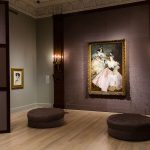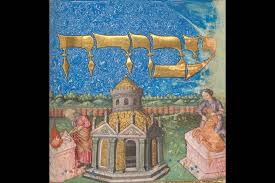Just in time for the Jewish High Holy Days, New York City’s >Metropolitan Museum of Art wil open a show titled “JERUSALEM: 1000 – 1400 EVERY PEOPLE UNDER THE SUN” It will run SEPTEMBER 26, 2016–JANUARY 8, 2017. Hashtagged with #MetJERUSALEM, the show will illuminate the key role that Jerusalem played in shaping the art of the period from 1000 to 1400. According the the exhibit, Jerusalem was home to multiple cultures, faiths, and languages. Over 200 works of art will be gathered from some 60 lenders worldwide. Nearly a quarter of the objects will come from Jerusalem, including key loans from its religious communities, some of which have never before shared their treasures outside their walls. Jerusalem 1000–1400: Every People Under Heaven will bear witness to the crucial role that the city has played in shaping world culture, a lesson vital to our common history (it will also stress – perhaps – that Jerusalem wasn’t just Jewish, and was a Rainbow mosaic of faiths). The curators are Melanie Holcomb and Barbara Boehm.


Alex Katz Pearlstein
Up a few block from The MET is New York’s JM – The JEWISH M– USEUM. Their two Fall 2016 exhibits will feature Pierre Careau’s Modern Architecture and Design; and Alex Israel and his Walls, Floors, and Ceilings. Alex Israel was born in Los Angeles in 1982, and currently resides there. His works explore how popular media, Hollywood, and the cult of celebrity are both central to Los Angeles, as well as an understanding of the American Dream.


Installation view of the exhibition John Singer Sargent’s Mrs. Carl Meyer and Her Children. September 16, 2016 – February 5, 2017. The Jewish Museum, NY. Photo by: Will Ragozzino/SocialShutterbug.com
MOMA, The Museum of Modern Art in Manhattan will show photo works from the collection of the Goldman Sachs banker and philanthropist Robert Menschel, as well as a show on refugees and displacement.
In November, The BROOKLYN M– USEUM will feature a show titled MARILYN MINTER: PRETTY DIRTYSpanning more than four decades, the exhibition begins with the artist’s earliest artworks, from 1969 through 1986, including rarely exhibited photographs as well as paintings incorporating photorealist and Pop art techniques. It continues with works from the late 1980s and 1990s that examine visual pleasure in visceral depictions of food and sex. The exhibition culminates in Minter’s ongoing investigation of how the beauty industry expertly creates and manipulates desire through images.
The NEUE GALLERIE on Manhattan’s Upper East Side will display the works of KLIMT this Fall in a show titled Klimt and the Women of Vienna’s Golden Age, 1900–1918 The exhibition will include approximately 12 paintings, 40 drawings, 40 works of decorative art, and vintage photographs of Klimt, including the Portrait of Adele Bloch-Bauer I (1907) and Portrait of Adele Bloch-Bauer II (1912); the Portrait of Szerena Lederer (1899); the Portrait of Gertha Loew (1902); the Portrait of Mäda Primavesi (1912); the Portrait of Elisabeth Lederer (1914-16), daughter of Szerena Lederer; and the unfinished Portrait of Ria Munk III (1917).
On October 28, 2016, the New York Historical Society will open a show: The First Jewish Americans: Freedom and Culture in the New World The curators ask: How did Jewish settlers come to inhabit—and change—the New World? Jews in colonial America and the young United States, while only a tiny fraction of the population, significantly negotiated the freedoms offered by the new nation and contributed to the flowering of American culture. The First Jewish Americans: Freedom and Culture in the New World follows the trajectory of a people forced from their ancestral lands in Europe, as well as their homes in South America and the Caribbean, to their controversial arrival in New Amsterdam in 1654 to the unprecedented political freedoms they gained in early 19th-century New York, Philadelphia, and Charleston. In this ground-breaking exhibition, rare portraits, drawings, maps, documents, and ritual objects illuminate how 18th- and 19th-century artists, writers, activists, and more adopted American ideals while struggling to remain distinct and socially cohesive amidst the birth of a new Jewish American tradition.
On September 22, the Center for Jewish History in NYC will launch HOLY TRASH: MY GENIZAH According to Solomon Schechter, a Genizah is “the storeroom or depository in a synagogue a cemetery in which worn-out and heretical or disgraced Hebrew books or papers are placed. In medieval times…their sanctity and consequent claim to preservation were held to depend on their containing the “names” of God.” The curators ask “What’s between the Genizah and today’s Jewish archive?” Holy Trash: My Genizah is a new project by fine arts and performance artist Rachel Libeskind created especially for the AJHS exhibition space in the great hall of the Center for Jewish History.
Closing soon is DANNY LYON: MESSAGE TO THE FUTURE at The Whitney Museum of American Art in New York City.
(The Tate in Liverpool will have a show on the works of the late YVES KLEIN, but please note that Mr. Klein was not Jewish)
The Israel Museum in Jerusalem will open a show on the treasures of the Jewish Ghetto of Venice in late September. It is titled, “Venetian Splendor – Marking 500 Years of the Venice Ghetto.” See it along with their new show on “A Mummy in Jerusalem: Secrets of the Afterlife.”
The Tel Aviv Museum of Art will launch five new shows this Fall, including one on KLIMT, and one on the Bauhaus (note… Walter Gropius was not a fan of Germany’s Jews whatsoever).
Closing in October at San Francisco’s Contemporary Jewish Museum is an exhibit on the works of Stanley Kubrick. Stanley Kubrick exerted complete artistic control over his projects; in doing so, he reconceived the genres in which he worked. The exhibition covers the breadth of Kubrick’s achievements, beginning with his photographs for LOOK magazine taken in the 1940s, and continuing with his directorial achievements of the 1950s through the 1990s, and explores Napoleon and Aryan Papers, two projects that Kubrick never completed, and the technological advances developed by Kubrick and his team. Upcoming this Fall, are shows on “From Generation to Generation: Inherited Memory and Contemporary Art,” which presents work by approximately twenty-five artists who grapple with memories that are not their own. There are many forms of memory: memories we have experienced, memories we have heard as family stories and from popular culture, even memories from an imagined future. Through their work, the artists in this exhibition search, question, and reflect on the representation of truths related to ancestral and collective memory—ultimately attempting to deal with their own past.
In October, The FIGGE ART M– USEUM in Davenport, Iowa will open “Rembrandt and the Jews: The Berger Print Collection,” which features a collection of 22 etchings by the Dutch master that explore the relationship between the artist and the Jewish residents of his Amsterdam neighborhood. As a companion to the exhibition, additional prints by Rembrandt and the work of his peers and predecessors Anthony van Dyck, Albrecht Dürer and other artists will be on view, drawn from the collections of the Figge, the University of Iowa, Augustana College, and Pella Historical Society and Museums. During the 17th century, The Dutch Republic, also known as the Netherlands, was an economic, scientific and artistic powerhouse that dominated international trade. Amsterdam, its financial and cultural capital, was a center of learning and a haven during a period of religious persecution across Europe. Refugees flocked to the city, including Sephardic Jews from Spain and Portugal who were forced to deny their religion in their home countries, but were free to reclaim these traditions in the Netherlands. Rembrandt lived in Amsterdam’s prosperous Jewish neighborhood, where he found patrons and models for his work. In his interpretation of Protestant Old Testament narratives, Rembrandt consulted Jewish theologians for a varied perspective of these familiar subjects. He also painted and etched portraits of prominent Jews in the city.
In Philadelphia, The National Museum of American Jewish History has launched a show titled “Bill Graham and the Rock and Roll Revolution.” From Jimi Hendrix to Santana to The Rolling Stones, Bill Graham has worked with many of the greats of rock and roll and has launched the careers of plenty of legends who gained their fame in the ’60s. Through rock memorabilia, photographs, psychedelic art and more, the National Museum of American Jewish History dives deep into the life of this notable promoter and manager, while exploring the cultural transformations that took place during the ’60s, ’70s, and ’80s in the world of rock and roll.
In Worcestor, Massachusetts, the museum will explore Renoir’s The Jewish Wedding. In 1875, Renoir was commissioned to paint a replica of Eugène Delacroix’s 1839 The Jewish Wedding in Morocco, today in the Musée du Louvre in Paris. Although faithful to Delacroix’s original, Renoir adapted his Impressionist manner to the painting, creating a novel work of art, wholly distinct in its brushwork, palette, and use of light.





